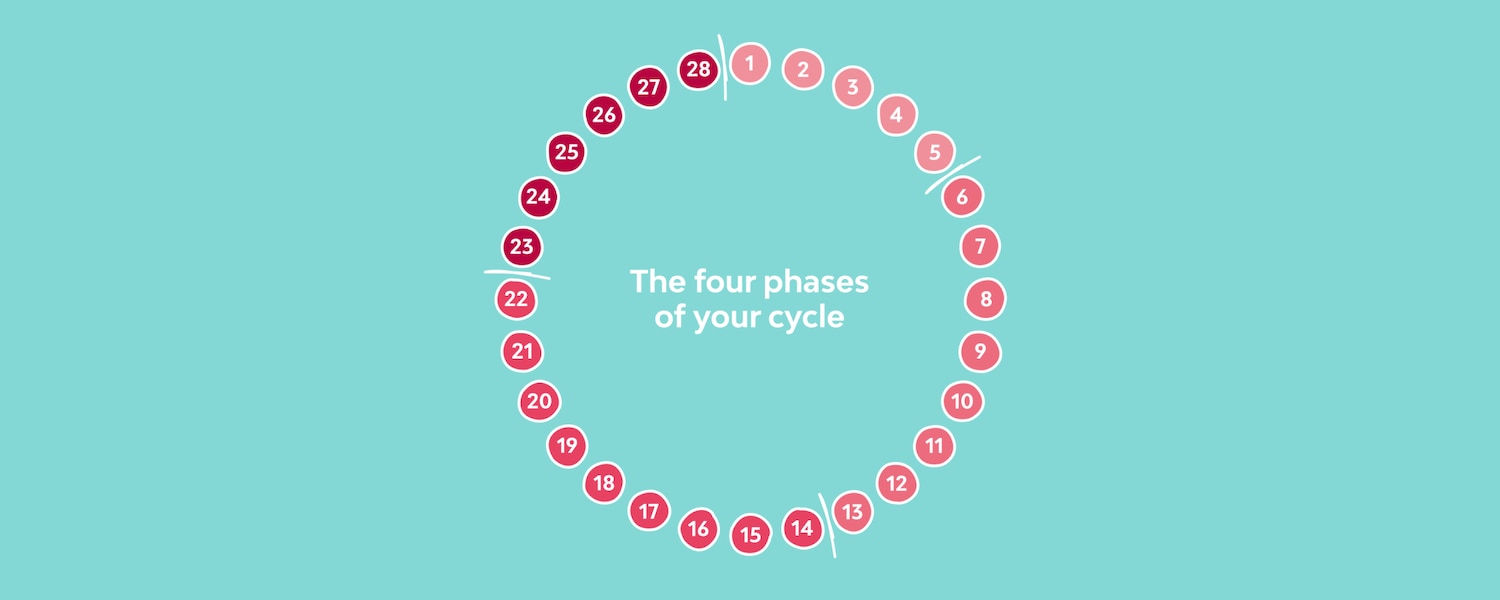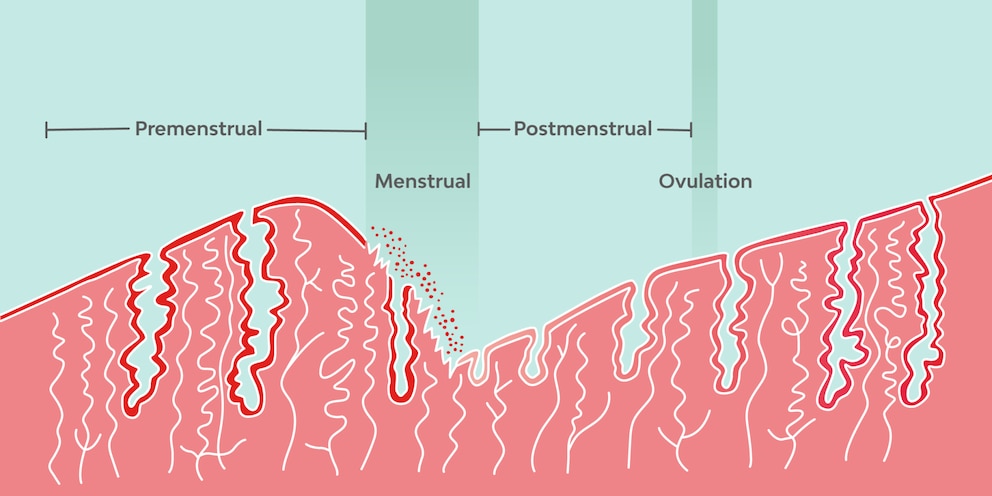What is the menstrual cycle?

Your menstrual (or period) cycle may sometimes be as unpredictable as the weather or it could follow a pretty regular pattern. Let’s take a better look at its different phases, so that you can be prepared for whatever your body may throw at you.
Let’s start with the basic facts: menstruation (the time when you’re bleeding, also known as your period) tends to occur once a month. Periods themselves usually start at some point during puberty, around the ages of 11 to 14, although they can start as early as 8 or 9, or as late as 15 or even 16. [1] Getting your period is a completely natural and normal process that is your body’s way of saying it can handle pregnancy. But don’t worry, it doesn’t mean that you have to have a baby yet!
As with most natural processes of the body, everyone’s menstrual cycle will be different, but most will follow a similar sort of pattern.
How long is a normal period cycle?
It’s pretty much a guarantee that everyone’s periods will differ in length and flow! They may even change as we get older – they aren’t something that we can really control. Generally speaking, periods happen every 21 to 40 days [1].
The day your period starts is calculated as the first day of your menstrual cycle. There’s a wide range of what’s considered to be a “regular” cycle – so try not to compare specific timelines or days with others as all our bodies work differently!
On the other hand, sometimes periods can be completely irregular and may not follow any specific pattern at all. You may experience spotting, particularly heavy periods, 1 day periods or even 2 periods in a month. This may seem unsettling and worrying at the time, but often it’s just a sign of your body adjusting to varying levels of hormones. Your period should eventually regulate itself naturally but if it doesn’t, it’s best to check in with your doctor to be on the safe side.

What are the phases of the menstrual cycle?
The menstrual cycle can be roughly divided in 4 different stages, each with its own special function. Curious? Let’s take a closer look at what happens in all of them!
The menstrual phase
The first phase of the menstrual cycle begins on the day that you get your period and is unsurprisingly called the menstrual phase! It happens when no sperm comes into contact with the egg that’s released into your uterus.
A drop in levels of the hormones oestrogen and progesterone stimulates your body to shed the thickened endometrial lining and the unfertilized egg out through your vagina as period blood. Bleeding usually lasts around 3-8 days. [2] You may find that you experience heavier bleeding during the first two days of your period.
During your period and just before it, you might experience mild pain in your lower abdomen. This is known as menstrual cramps and it’s mostly caused by the womb tightening in order to shed the uterus lining. Even though period pains aren’t exactly something we look forward to, they are extremely common! But no worries, exercise and over-the-counter painkillers can significantly reduce any discomfort – although if the pain is too strong, then it’s best to speak to your doctor.
The follicular phase
The follicular phase also starts during your period (so yes, there is a bit of an overlap) and will last until your ovaries release a new egg. In the follicular phase, your brain produces a hormone called follicle stimulating hormone (FSH) and it signals the ovaries to prepare an egg for ovulation.
The surge in oestrogen that occurs during this phase means that your endometrial lining begins to thicken once again. The follicular phase lasts until ovulation happens and this can take anywhere from 10 to 17 days, depending on your cycle. [3]
The ovulation phase
You may have guessed it from the name, but this phase is where ovulation occurs. It is essentially what happens when one of your ovaries releases a follicle (that contains an egg) into the fallopian tube.
Ovulation is prompted by rising levels of oestrogen, which stimulate the brain to produce another hormone called luteinising hormone (LH). As the amount of LH in your body continues to increase, ovulation is triggered and your egg begins its journey through the fallopian tubes and towards the uterus. During this phase, you will be the most fertile and have the highest chances of getting pregnant.
You may notice that you produce a thick white discharge and even find that your sex drive increases; it’s your body’s way of telling you that now is a good time to make a baby.
The luteal phase
During ovulation, the follicle (that contained the egg) transforms into a mass of cells known as the corpeus luteum. This mass then starts to release progesterone as well as oestrogen.
If the egg is fertilised, the progesterone from the corpus luteum helps support the early stages of pregnancy. However if the egg is not fertilised, the corpus luteum breaks down and the drop in progesterone causes the endometrium lining to shed and trigger menstruation. [4]
You may notice some emotional and physical changes during this phase. You might feel a bit bloated and nauseated; your breasts can get bigger and you may even get diarrhoea. You could also feel sad, irritable or weepy. These symptoms are common and they are known as premenstrual syndrome or PMS.
After the luteal phase, the whole cycle starts all over again!
The process of the menstrual cycle is repeated around 450 times (yes, really) in your life until the menopause takes place and periods eventually stop. [5] It’s quite a lot to process, but luckily our body does it automatically (thanks, Mother Nature!). And although you may not have to think about it every day, understanding the menstrual cycle can help you to better appreciate how your body works. If you want to read more on living with periods, check out our pages on what helps period pain and signs of your period coming.
Medical disclaimer
The medical information in this article is provided as an information resource only and is not to be used or relied on for any diagnostic or treatment purposes. Please consult your doctor for guidance about a specific medical condition.
[References]
[1] https://kidshealth.org/en/kids/when-period.html
[2] https://www.nhs.uk/conditions/periods/
[3] https://www.mayoclinic.org/healthy-lifestyle/womens-health/in-depth/menstrual-cycle/art-20047186
[4] https://intermountainhealthcare.org/blogs/topics/intermountain-moms/2014/02/ovulation-made-simple-a-four-phase-review/
[5] source-6https://www.helpingwomenperiod.org/7-amazing-facts-about-periods-that-everyone-needs-to-know/


